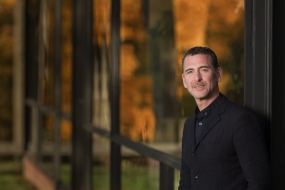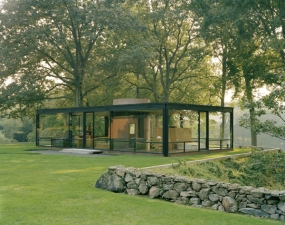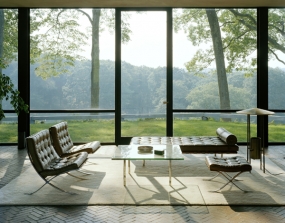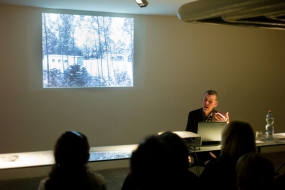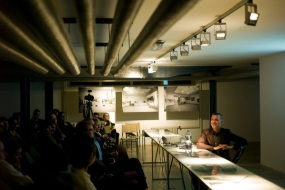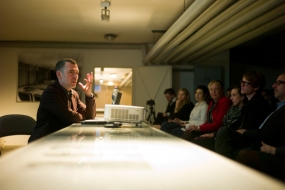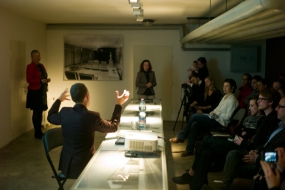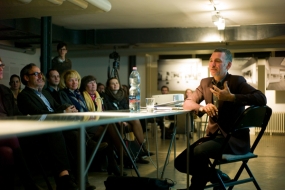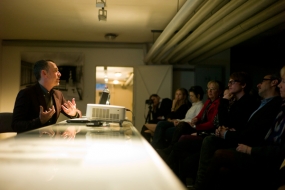The Glass House by Philip Johnson
The Glass House was completed in 1949 on a nearly 50-acre property in New Canaan, CT. A private house of architect Philip Johnson, is now one of the major works of world architecture. Along with several other buildings (pavilion by the lake, picture and sculpture galleries, guest house, tower, entrance building) that Johnson designed and built on his property over the next fifty years, it represents a unique synthesis of art, architecture and the surrounding landscape.
Johnson's Glass House is a "dematerialized quote" of the Farnsworth House by Ludwig Mies van der Rohe. It was built in River Road, Illinois in 1945–1951 in an atmosphere of complex communication between Mies and a wealthy client, a Chicago doctor Edith Farnsworth. Johnson meanwhile as curator of the Museum of Modern Art (MoMA) in New York prepared a large retrospective exhibition of works by Ludwig Mies van der Rohe in MoMA (1947). This show significantly inspired Phyllis Bronfman-Lambert, the daughter of the President of Seagram Corporation, when she had been instructed to find a suitable architect for the construction of the administrative building on Park Avenue in New York. She chose Mies, who invited Philip Johnson to cooperate. He then mainly took care of designing interior furnishings, both in the administrative and the representative parts of the building. Construction of the Seagram Building skyscraper (1954–1958) was the first implementation of a high-rise building for both architects, in addition to its exceptional urban gesture. In contrast to the established building, but also the economic rules in the New York area, it has provided residents of the city with an exceptionally generous public space. The Seagram Building by Mies and Johnson is considered the quintessence of a 20th century skyscraper. Phyllis Lambert later became the author of the publication on the monumental opus, "Mies van der Rohe in America" (2001).
Johnson openly declared the inspiration by Mies in designing his own Glass House. British architect and architectural theorist Kenneth Frampton interpreted Mies’ Farnsworth House as a "tectonic" concept, while Johnson’s Glass House as a "scenic" concept. Unlike Mies’ house, Johnson’s does not "float" above the ground, but it is firmly "established" in it. Since 2007, the Glass House has been a publicly accessible monument managed and protected by the National Trust for Historic Preservation. Find more at http://theglasshouse.org/
Philip Johnson (1906–2005) is also connected with Brno. As Petr Pelčák recalled in his lecture at Villa Tugendhat in December last year, and Vladimír Šlapeta mentioned in his own review, Johnson visited Brno in August 1930 and looked at the just completed Villa Tugendhat. He lived in a villa by Otto Eisler, who was also the only architect with whom he met and with whom he had an emotional relationship. In 1939, just before the outbreak of the Second World War, he visited Brno again. He met again with Otto Eisler, who was shortly after his release from an arrest by the Gestapo. Johnson, who has tended to fascism since 1933, was appalled by the state of his friend. It was only in 1940 when he finally understood the destructiveness of this ideology and became a staunch American Democrat.
Henry Urbach has been the director of The Glass House since 2012. He worked as a curator at the Museum of Modern Art in San Francisco and in the Gallery of Contemporary Art and Architecture in New York. He is the author of numerous publications, lectured at universities in Los Angeles, New York and New Haven. As a historian and theorist of architecture he was awarded several times (at Princeton University and Columbia).
The lecture will be held on Monday 24 February 2014 at 5 p.m. on the technical basement floor of Villa Tugendhat (a tour of the villa is not included in the lecture). The lecture will be in English and will not be interpreted.
Entrance fee is 100,- CZK, students and senior citizens 50,- CZK.
An advance booking is required for the lecture, by telephone at +420 515 511 015/017
or e-mail: info@tugendhat.eu (limited capacity of 70 people).
A poster for the lecture can be downloaded here.

